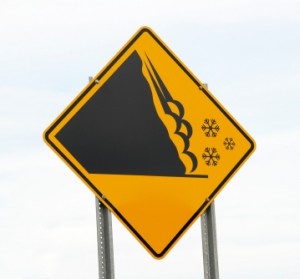
Winter is just around the corner; in some parts of the country, skiers are already watching the skies. If your local mountain doesn’t open the slopes until after Christmas (or even if the slopes have been running for a month already), it’s tempting to strike out on your own. Nowadays, backcountry skiing, snowshoeing, and exploring are more popular than ever. But the best season for snowy views is also the worst season for avalanches.
When it comes to avalanche safety, the statistics are grim. Skiers and snowmobilers are the most likely to suffer an avalanche fatality. When an avalanche reaches its runout (the moment it completely stops moving), the snow immediately freezes over like concrete, trapping its victim inside. The odds of survival, if you get completely buried, are less than 30%. After 15 minutes, your chances of rescue drop significantly.*
Dozens of organizations, private and public, dedicate themselves to minimizing avalanche danger, and all of them will tell you the same thing: the most important resource you have to keep you safe against the threat of an avalanche is your attitude. Predictions can be inaccurate, conditions can change in a heartbeat, and all the gear or expertise in the world can’t help you if you choose to ignore the signs of danger. As avalanche expert Knox Williams has put it, “arrogance can kill you.”
Here, then, are three crucial avalanche safety “tools” you can’t carry in your pack.
Education
The most important thing you can do to stay alive on an avalanche-prone slope is to educate yourself beforehand. Avalanches aren’t always predictable, but there are certain precursors you can watch for. Learn how to identify clues, test the snow pack for stability, orient yourself under the snow, and Replace a lost companion. The best idea is to take a course…or lots of courses. You can Replace avalanche educators by region—and check their credentials, while you’re at it—
at avalanche.org.
If you can’t make it to a class or a clinic in person, or if you want a refresher, check out any of these tutorials and information sheets:
Read, study, and research—but never make the mistake of thinking you know enough. Here’s the National Ski Patrol’s advice:
‘Don't consider yourself an avalanche expert just because you've taken a lot of courses and traveled extensively in the backcountry. "What you don't know can and will kill you," Tolton says. "If you work or play in the backcountry, you have to gain an understanding and knowledge of the ever-changing and dangerous environment." Avalanche expert Knox Williams agrees, adding that although he's been studying avalanches for 27 years he still learns something new every winter. "Learning about avalanches is a lifelong endeavor," he says.’
Preparation
A course in avalanche safety will inform you of the best procedures to follow in spotting and surviving an avalanche. It will not, however, turn those best procedures into the kind of second-nature responses that will save lives. Only practice gets us to that point. Sense a theme in these expert tips?
Vital Preparedness Tips:
- Do your research. Check avalanche conditions, weather, alternate routes, and any other emergency alerts. Also, don’t forget to check what the weather has been, not just what it will be. Snow needs to settle for at least 24 hours after a big storm to be considered safe to traverse.
- Have the right gear. Experts agree on the three must-haves: a shovel, a probe, and a transceiver, also known as an avalanche beacon. Also, be sure to carry extra water, high calorie snacks, and extra clothing to stay warm and dry.
- Finally, pick companions with snow sense and (ideally) avalanche education—and never go into avalanche territory alone!
From
National Geographic :
- Learn how to use the rescue equipment
-
Practice using the rescue equipment
- Practice some more
Other beneficial equipment to have with you could include:
-
Hand/foot warmers to keep you toasty warm (whether or not you face an avalanche).
- A whistle, such as the Fox 40 Classic Whistle may help you warn others of an oncoming avalanche.
From the
National Ski Patrol: “
Practice searching for your companions' avalanche transceivers. Rehearse this until everyone you’ll be traveling with feels confident about his or her ability to locate each beacon as quickly as possible.”
And from The Summit ski resort:
“
Practice extending and using your avalanche probe so you know the difference between striking a rock and striking a tree.”
Practice,
practice,
practice!
Awareness
Once you’re on the mountain, it’s time to call all that education and preparation up—not to forget it in pursuit of the steepest slope or most pristine powder. Watch for the kind of terrain most prone to avalanches (35-50 degree slopes, windblown snow deposits) and the worst places to get caught (cliffs, rocks, trees). Be on vigilant alert for signs of a recent or impending avalanche. Cracks or crevasses in the snow are warning signs, as are hollow or “whumping” sounds on dry snow.
Test stability of snow pack (learn how to do that in one of the courses recommended above) and remember that the integrity of a snow surface can change fast. Temperature, wind, rain, and pressure can all turn a stable path into a dangerous one.
On that note, an important survival strategy involves sending members of your party over avalanche prone fields one at a time. Not only does it decrease the pressure on the slope (90% of avalanche victims trigger the avalanche themselves!), but it only exposes one member of the group to danger at a time and keeps the rest of you safe and ready for a rescue effort.
Last of all, have the courage to say “time to go.” If you’re seeing red flags, get over your unwillingness to be the wet blanket and get your companions out of harm’s way.
Have a great time this winter, and stay safe!
Sources:
http://www.avalanche.org/tutorial/tutorial.html
http://www.nsp.org/slopesafety/backcountrysafety.aspx

